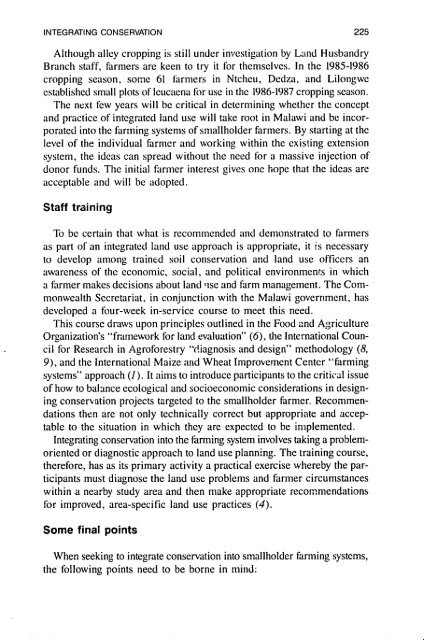Conservation farming on steep lands - USAid
Conservation farming on steep lands - USAid
Conservation farming on steep lands - USAid
You also want an ePaper? Increase the reach of your titles
YUMPU automatically turns print PDFs into web optimized ePapers that Google loves.
INTEGRATING CONSERVATION 225<br />
Although alley cropping is still under investigati<strong>on</strong> by Land Husbandry<br />
Branch staff, farmers are keen to try it for themselves. In the 1985-1986<br />
cropping seas<strong>on</strong>, some 61 I'armers in Ntcheu, Dedza, and Lil<strong>on</strong>gwe<br />
established small plots of leucaena for use in the 1986-1987 cropping seas<strong>on</strong>.<br />
The next few years will be critical in determining whether the c<strong>on</strong>cept<br />
and practice of integrated land use will take root in Malawi and be incorporated<br />
into the <str<strong>on</strong>g>farming</str<strong>on</strong>g> systems of smallholder farmers. By starting at the<br />
level of the individual farnlcr and working within the existing extensi<strong>on</strong><br />
system, the ideas can spread without the need for a massive ilijecti<strong>on</strong> of<br />
d<strong>on</strong>or funds. The initial farmer interest gives <strong>on</strong>e hope that the ideas are<br />
acceptable and will be adopted.<br />
Staff training<br />
To be certain that what is recommended arid dem<strong>on</strong>strated to farmers<br />
as part of an integrated land use approach is appropriate, it is necessary<br />
to develop am<strong>on</strong>g trained soil c<strong>on</strong>servati<strong>on</strong> and land use officers an<br />
awareness of the ec<strong>on</strong>omic, social, and political envir<strong>on</strong>menls in which<br />
a farmer makes decisi<strong>on</strong>s about land llse and farm management. The Comm<strong>on</strong>wealth<br />
Secretariat, in c<strong>on</strong>juncti<strong>on</strong> with the Malawi government, has<br />
developed a four-week in-service course to meet this need.<br />
This course draws up<strong>on</strong> principles outlined in the Food and Ai;riculture<br />
Organizati<strong>on</strong>'s "frdmework for land evaluati<strong>on</strong>" (6), the Internati<strong>on</strong>al Council<br />
for Research in Agroforestry "diagnosis and design" methodology (8,<br />
9), and the Internati<strong>on</strong>al Maize and Wheat Improvement Center "<str<strong>on</strong>g>farming</str<strong>on</strong>g><br />
systems" approach (I). It airns to introduce participants to the critical issue<br />
of how to balance ecological and socioec<strong>on</strong>omic c<strong>on</strong>siderati<strong>on</strong>s in designing<br />
c<strong>on</strong>serkati<strong>on</strong> projects targeted to the sn~allholder farmer. Recommendati<strong>on</strong>s<br />
then are not <strong>on</strong>ly technically correct but appropriate and acceptable<br />
to the situati<strong>on</strong> in which they are expected to be implemented.<br />
Integrating c<strong>on</strong>servati<strong>on</strong> into the Fdrrning system involves taking a problemoriented<br />
or diagnostic approach to land use planning. The training course,<br />
therefore, has as its primary activity a practical exercise whereby the participants<br />
must diagnose the land use problems and farmer circumstances<br />
within a nearby study area and then make appropriate recommendati<strong>on</strong>s<br />
for improved, area-specific land use practices (4).<br />
Some final paints<br />
When seeking to integrate c<strong>on</strong>servati<strong>on</strong> into smallholder <str<strong>on</strong>g>farming</str<strong>on</strong>g> systems,<br />
the following points need to be borne in mind:
















